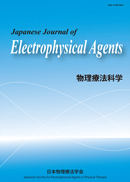Volume 21, Issue 1
Displaying 1-16 of 16 articles from this issue
- |<
- <
- 1
- >
- >|
-
2014Volume 21Issue 1 Pages 01-08
Published: 2014
Released on J-STAGE: September 03, 2022
Download PDF (553K) -
2014Volume 21Issue 1 Pages 09-13
Published: 2014
Released on J-STAGE: September 03, 2022
Download PDF (503K)
-
2014Volume 21Issue 1 Pages 14-16
Published: 2014
Released on J-STAGE: September 03, 2022
Download PDF (204K) -
2014Volume 21Issue 1 Pages 17-20
Published: 2014
Released on J-STAGE: September 03, 2022
Download PDF (715K) -
2014Volume 21Issue 1 Pages 21-24
Published: 2014
Released on J-STAGE: September 03, 2022
Download PDF (871K)
-
2014Volume 21Issue 1 Pages 25-31
Published: 2014
Released on J-STAGE: September 03, 2022
Download PDF (1166K) -
2014Volume 21Issue 1 Pages 32-39
Published: 2014
Released on J-STAGE: September 03, 2022
Download PDF (429K) -
2014Volume 21Issue 1 Pages 40-44
Published: 2014
Released on J-STAGE: September 03, 2022
Download PDF (391K) -
2014Volume 21Issue 1 Pages 45-52
Published: 2014
Released on J-STAGE: September 03, 2022
Download PDF (1591K) -
2014Volume 21Issue 1 Pages 53-58
Published: 2014
Released on J-STAGE: September 03, 2022
Download PDF (420K) -
2014Volume 21Issue 1 Pages 59-63
Published: 2014
Released on J-STAGE: September 03, 2022
Download PDF (544K)
-
2014Volume 21Issue 1 Pages 64-68
Published: 2014
Released on J-STAGE: September 03, 2022
Download PDF (505K) -
2014Volume 21Issue 1 Pages 69-74
Published: 2014
Released on J-STAGE: September 03, 2022
Download PDF (825K)
-
2014Volume 21Issue 1 Pages 75-78
Published: 2014
Released on J-STAGE: September 03, 2022
Download PDF (494K) -
2014Volume 21Issue 1 Pages 79-87
Published: 2014
Released on J-STAGE: September 03, 2022
Download PDF (937K) -
2014Volume 21Issue 1 Pages 88-94
Published: 2014
Released on J-STAGE: September 03, 2022
Download PDF (716K)
- |<
- <
- 1
- >
- >|
